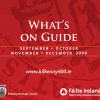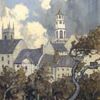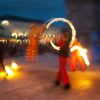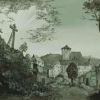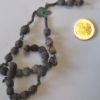History
A Brief History of Kilkenny City
Four hundred years ago, James I, King of England granted Kilkenny a charter conferring on it the status of a city, with the title of Mayor for its chief citizen. Four hundred years before that, in 1207, William Marshall, Lord of Leinster, had given Kilkenny a charter setting out the rights of its burgesses and freemen. Its first Council was elected in 1231 and since then Kilkenny has had a continuous record of municipal government. From the 13th century to the end of the 16th the chief magistrate was known as the Sovereign, and since then as Mayor.
Even before the Norman Invasion, there was an urban settlement here. Cill Chainnigh was a stronghold of the kings of Ossory, the Mac Giolla Phádraig family. This early settlement centred on St. Canice’s Cathedral, was known in after years as the Irishtown of Kilkenny, and formed a separate town from the Hightown, with its own Corporation until the 1830s.
Kilkenny retains many buildings from the early centuries of its existence. The Round Tower at St. Canice’s is at least 900 years old; the Talbot Tower, now under reconstruction, was built around 1260; there are five medieval churches dating from the 13th century; Rothe house is the best known of a series of merchants’ houses from the late 16th and early 17th centuries; a number of fine Georgian houses are to be seen on our streets. The two outstanding buildings in the city are Kilkenny Castle, and St. Canice’s Cathedral.
As well as its built heritage, Kilkenny has an outstanding written record. The Tholsel on High Street is our city hall and houses a marvellous collection of documents from the 13th century to the present day. As well as the charters mentioned already, there are deeds, grants, leases and record books giving a unique insight into the governance of Kilkenny over the centuries. The gem of the collection is Liber Primus Kilkenniensis, a manuscript record of urban records containing a copy of William Marshall’s charter, and continuing to the 16th century.
Time Line for Kilkenny City
11th and 12th centuries St. Canice’s Round Tower. Cill Chainnigh the centre of power in Kingdom of Osraighe.
1111 Old church of St. Canice adopted as Cathedral of diocese of Ossory
1169 Robert FitzStephen and Meiler FitzHenry land at Bannow Bay to help Diarmaid Mac Murchadha recover the kingdom of Leinster. After capturing Wexford, they make their first raid into Osraighe
1172 Strongbow builds a wooden motte and bailey castle at Kilkenny
1189 William Marshall marries Strongbow’s daughter Isabel and becomes Lord of Leinster
1205 Start of work on Cathedral of St. Canice
1205 (approximately) St. Mary’s Church
1207 William Marshall, Earl of Pembroke, gives Kilkenny its first charter as a town.
1211 St. John’s Priory built by William Marshall
1225 Black Abbey founded by William Marshall the younger
1231 St. Francis Abbey founded by Richard Marshall
1231 Kilkenny elects its first Sovereign (the equivalent of Mayor)
Quote : Memorandum that on the Friday immediately following the feast of St. Michael the Archangel A.D. 1231 it was ordained and established by assent of the community of Kilkenny that at every feast of St. Michael the Archangel the said community should be assembled to elect their sovereign and the twelve who are best and can govern and counsel their sovereign to the profit of the said community…
1244 The bishop of Ossory gives the Dominicans of the Black Abbey the right to draw water from St. Canice’s Well – Kenny’s Well –document in Corporation archives
1245 Anselm Marshall the last of William Marshall’s sons dies. Leinster is divided between his five sisters. Isabelle, the widow of the Earl of Gloucester gets County Kilkenny. Their descendants, the de Clare earls of Gloucester hold Kilkenny until 1314.
1250 First Murage Grant (the right to collect taxes to build a wall around Kilkenny)
1260 (approximately Building of the Talbot Tower at south-west corner of wall
1314 At the Battle of Bannockburn near Stirling in Scotland, Robert Bruce defeats the English army. Among the dead is Gilbert de Clare, Earl of Gloucester. He has no male heir, so County Kilkenny is divided among his three sisters. Eleanor gets the town of Kilkenny. Her husband is Hugh Le Despenser, and the Despensers hold Kilkenny for most of the 14th century.
1315 Edward Bruce invades Ireland with a Scots army. He is killed in 1318.
1324 Trial of Alice Kyteler for witchcraft. Petronilla de Media found guilty and burned.
1329 James Butler is given the title Earl of Ormond.
1348-49 Friar John Clyn writes an account of the Black Death in Kilkenny
1366 Lionel, Duke of Clarence holds a parliament at Kilkenny. A series of laws called the Statutes of Kilkenny are passed.
1383 King Richard II of England confirms the charters of William Marshall and his son and confirms other rights to the citizens of Kilkenny.
1391 James Butler, third Earl of Ormond buys Kilkenny Castle
1394 King Richard II in Kilkenny. The Earl of Ormond, a fluent Irish speaker, is his chief adviser.
1461 James Butler, fifth Earl of Ormond is executed after the battle of Towton in England, where Edward IV defeats Henry VI and takes his place as King of England.
1461 The dead earl’s brother Sir John Butler is defeated at the battle of Piltown, in South Kilkenny by the Earl of Desmond, a supporter of Edward IV. The town of Kilkenny supplied men for the Butler army and lost their rights as a result.
1466 Act of Parliament restoring the rights of Sovereign, William Archer, and to the Burgesses of Kilkenny.
1515 Thomas, 7th Earl of Ormonde dies. After his death Sir Piers Rua Butler becomes the chief power in Ormond, but does not get the title of 8th Earl until 1538
1536 Henry VIII declared Supreme Head of the Church in Ireland
1540 St. Francis Abbey and St. John’s Priory suppressed
1543 Black Abbey suppressed
1546 James 9th Earl of Ormond (Séamus Bacach) poisoned at a feast at Holborn in London.
1564 A great flood in which St. John’s Bridge and Castle fell down.
1565 Thomas 10th Earl of Ormond (Tomás Dubh) defeats the Earl of Desmond at Affane – the last “private” battle between noblemen in Ireland. Both earls were brought to London and reprimanded, but only Desmond was imprisoned in the Tower of London.
1569 The Earl’s brothers revolt against the crown. Kilkenny is besieged for some days, but survives.
1579 Earl Thomas made Lord General of the army in Munster to deal with the rebellion of he Earl of Desmond.
1582 The Shee Alnshouse in Rose Inn Street is founded by Sir Richard Shee.
1594 – 1610 Rothe House built
1597 The defences of Kilkenny strengthened during the Nine Years War
1603 Churches in Kilkenny seized by citizens for Catholic Worship. Lord Mountjoy has Walter Archer, Sovereign of Kilkenny imprisoned.
1609 A charter of James I makes Kilkenny a city, and its chief magistrate is to be known as Mayor instead of Sovereign.
1616 Three mayors of Kilkenny removed from office in turn for not taking the oath of Supremacy.
1635 Inquisition at Kilkenny into the lands of Idough, around Castlecomer. O’Brennans, Lord Mountgarret and Richard Butler lose their lands in Idough.
1641 As the Rebellion started in Ulster spreads south, Lord Mountgarret takes charge of Rebel forces in Kilkenny
1642 Confederation of Kilkenny. Confederate Catholics set up a legislative assembly, and a Supreme Council to govern the parts of Ireland in rebel hands.
1649 End of the Confederate Assembly as they make peace with the Royalists led by the Earl of Ormonde.
1650 After a short siege and assault, Kilkenny surrenders to Cromwell.
1654 Kilkenny ruled by Daniel Axtel as Military Governor. No mayor for two years.
1662 Restoration of Charles II as King of England. Ormonde is made a duke and returns to Ireland as Lord Lieutenant.
1676 The Duke of Ormonde presents a silver mace to the City of Kilkenny.
1687 King James II gives Kilkenny a new charter. Catholics return to Corporation.
1690 William III, having defeated King James at the Battle of The Boyne, cancels the charter of James II.
1715 The Second Duke of Ormonde flees to France. He joins the Jacobites (supporters of the Stuart Kings)
1717 An act “for the better regulating of the Corporation of Kilkenny and the strengthening of the protestant position therein” is passed by the Irish Parliament.
1718 Proclamation declaring that the Duke of Ormonde is planning to invade Ireland with a Jacobite army.
1759 – 1761 The Tholsel (city Hall) in High Street is built.
1763 A great flood sweeps away both bridges in the city.
1771 The Market Cross, built in 1335 is removed.
1782 Burrel’s Hall in James’s Street is opened as a Catholic school by the Diocese of Ossory.
1782 County Hall, formerly Kilkenny College built
1829 Richard Sullivan and Redmond Reid became councilmen of Kilkenny Corporation, having taken “the oath required for the relief of his majesty’s Roman Catholic Subjects.”
1830 Twenty-eight catholic freemen were admitted, having taken the same oath.
1831 St. Canice’s Catholic Church consecrated.
1832 Richard Sullivan elected a Member of Parliament
1836 Redmond Reid elected mayor, the first Catholic in almost a century and a half.
1843 – 1857 St. Mary’s Cathedral is built.
1842 Daniel O’Connell holds one of his Monster Meetings at Robert’s Hill, near Kenny’s Well to demand Repeal of the Act of Union
1842 Kilkenny Workhouse built to house 1,200 paupers
1843 First election to reformed Kilkenny Corporation. Twenty-four repealers elected to fill the twent-four places. Edmund Smithwick mayor.
1845 Failure of the potato crop leads to famine.
1846 Famine fever killed at least 1,300 people in the year beginning September 1846
1847 In March Kilkenny Workhouse held 2,228 people at the height of the famine.
1848 First railway engine arrives in Kilkenny in April. In July first excursion by rail to Thomastown continues by coach and steamer.
- William Smith O’Brien in Kilkenny fails to get support for the Young Ireland Rising.
- James Stephens of Kilkenny, later founder of the Fenians, travels to Ballingarry to join Smith O’Briens rising at Ballingarry.
- Dr. Robert Cane, former mayor is imprisoned after the rising.
1849 On his release, Dr. Cane is elected Mayor for the second time.
1858 James Stephens founds the Fenians or Irish Republican Brotherhood in Dublin.
1865 Stephens arrested and escapes from jail.
1890 After the Parnell split, the Parnellite candidate is defeated in the Kilkenny by-election.
1904 King Edward VII visits Kilkenny.
- Kilkenny win their first All-Ireland Hurling Title
1917 W.T. Cosgrave wins a by-election in Kilkenny for the Sinn Féin Party.
1922 Republican forces in Kilkenny Castle are attacked by Free State forces during Civil War.
1935 Kilkenny Castle is closed up and the Ormonde family leaves Ireland
1965 Kilkenny Design Workshops open.
1967 The Marquess of Ormonde presents Kilkenny Castle to the people of Kilkenny.



